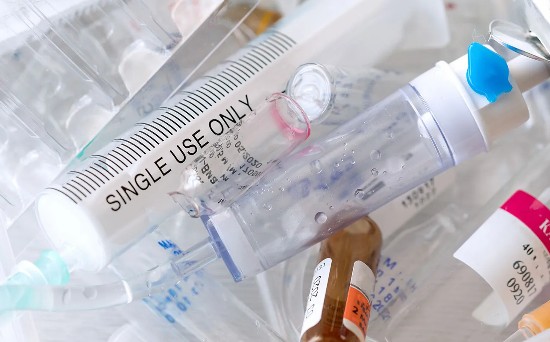I have borrowed the title of this piece from the concluding phrases of a viewpoint article that appeared in the Journal of American Medicine (JAMA) this week. Even medicine has been infected by throwaway and single-use plastics to the point that the planet’s health and those who live on it are in crisis. The article calls for “transformative changes” in regulations, healthcare organizations and the manufacturers of biomedical products.
Many years ago I did some consulting work at Toronto’s Hospital for Sick Children. My focus was on the design of a system to manage one-time-use plastic materials for interventional radiology cases. All the plastic equipment used for interventional procedures came with shelf expiry dates and caseload volumes required an order tracking, use, outcome and disposition record for every procedure and patient. Plastic devices that got shoved to the back of the closet would have past best before-dates and were costing the Radiology Department tens of thousands of dollars every year. The stuff was either being thrown out having never been used, or was being sent to countries where healthcare providers were willing to overlook the expiry dates.
What was behind these best-before dates? When you buy milk or other perishable items at a grocery store, best-before dates are featured prominently. That doesn’t mean that on the expiry date, the milk you paid good money for has gone sour. The best-before dates on a lot of items are highly misleading because so many things with date stamps remain viable for days, weeks, and in some cases months after.
The biopharmaceutical industry, not to be outdone by perishable food providers, has bought into the expiry-date mantra. The use of best-before dates drives consumption which means reorders and greater profits. That appears to be what is behind describing plastic items for so many medical procedures as being for single-use only.
Even government health authorities have bought into the nonsense requiring rigorous processes and data that promote single-use over reusability. But could plastic devices used once be sterilized and disinfected without impairing their function or causing harm to patients? We don’t know because no one appears to be doing the testing even in animal studies.
And even if a plastic device could be reused, the manufacturer for liability reasons is likely to slap a one-time use label on it to discourage hospitals from even considering reuse. The result is there is little in the way of a market for multi-use plastic medical devices despite the existence of autoclaves which have been around since 1879. Autoclaves work like pressure cookers and reliably sterilize medical tools. Surprisingly, autoclaves can sterilize all kinds of plastic found in medical supplies.
In the United States and elsewhere, however, the reuse of plastic medical devices seems almost absent. Hospitals have gotten into the habit of throwing away stuff used once. Some of this behaviour makes sense. Where masks and surgical gowns made of cloth were once sent to the laundry to be cleaned for reuse, today, hospitals dispose of paper-based equivalents. Hospitals have hazardous waste protocols for such items. The one-time use plastic catheter tube, syringe, or specimen cup which is treated as waste in the same way, however, poses a far greater biohazard because the chemicals, microparticles and nanoparticles in plastic can persist for years if not centuries. Incineration puts the stuff into the air. Burying in landfills puts the contaminants into the soil and groundwater.
One-time-use plastic, therefore, is contributing harm to the environment and human health. And one-time-use plastic in healthcare is doing the same which seems strange when you consider that hospitals are supposed to be focusing on keeping people healthy.
In the JAMA article it provides some interesting statistics:
- 98% of plastic comes from fossil fuels which contribute greenhouse gasses (GHGs) and toxic air emissions that are associated with global warming.
- Healthcare contributes 5% of these GHGs with a significant portion coming from single-use plastic first manufactured and then turned into waste.
Other points the JAMA article notes include:
- Plastics do not biodegrade easily and when they do become micro and nanoparticles that are ingested by plants and animals entering the food chain.
- Plastics contain carcinogens, neurotoxins, organic pollutants and endocrine disrupters.
Knowing all of the above it is surprising to see that healthcare delivery and the devices and materials used are becoming more single-use rather than reusable focused. Catheters, surgical instruments, and specialized equipment containing plastic are all disposed of after a single patient interaction. This is industry-driven planned obsolescence focused on profits rather than environmental sustainability. And because single-use is now predominant, there is little evidence to support reusability reinforcing the behaviour of the former over the latter.
Today, we ingest plastic from single-use water bottles. Plastic is everywhere. It is in the soil, the water, and the food we eat. Do we have an inkling of what this is doing to human health let alone the health of the rest of life on Earth?
















